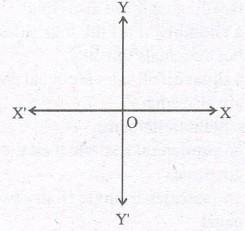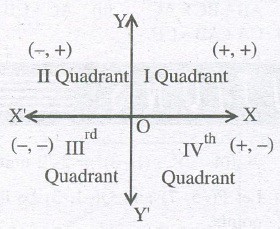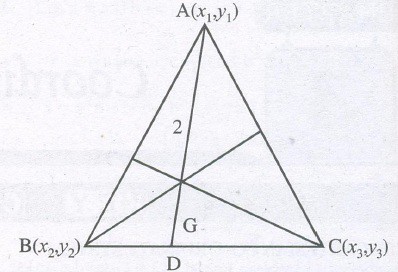CBSE Class 10 Maths Coordinate Geometry – Get here the Notes for CBSE Class 10 Maths Coordinate Geometry. Candidates who are ambitious to qualify the CBSE Class 10 with good score can check this article for Notes. This is possible only when you have the best CBSE Class 10 Maths study material and a smart preparation plan. To assist you with that, we are here with notes. Hope these notes will help you understand the important topics and remember the key points for exam point of view. Below we provided the Notes of CBSE Class 10 Maths for topic Coordinate Geometry.
- Class: 10th
- Subject: Maths
- Topic: Coordinate Geometry
- Resource: Notes
CBSE Notes Class 10 Maths Coordinate Geometry
Candidates who are pursuing in CBSE Class 10 are advised to revise the notes from this post. With the help of Notes, candidates can plan their Strategy for particular weaker section of the subject and study hard. So, go ahead and check the Important Notes for CBSE Class 10 Maths Coordinate Geometry from this article.
THE CARTESIAN CO-ORDINATE SYSTEM
Let X’OX and YOY’ be two perpendicular straight lines meeting at fixed point 0 then X’OX is called the x—axis and Y’OY is called the axis of y or y axis. Point
‘0’ is called the origin. x axis is known as abscissa and y—axis is known as ordinate.

NOTE : The x- axis and y— axis are mutually perpendicular to each,other that is why, this system of coordinates is also called Rectangular cartesian coordinate system.
QUADRANTS

The coordinate axes X’OX and Y’OY devide the plane into four parts, called quadrants, numbered I, II, III and IV anti-clockwise from OX.
NOTE : The coordinates of a point on the x-axis are of the form (x, 0), and of a point on they— axis are of the from (0,y).
DISTANCE FORMULA
The distance between two points whose co—ordinates are P (x1, y1) and Q (x2, y2)
given by the formula √(x2 — x1)2 + (y2 — y1 )2
DISTANCE FROM ORIGIN
√(x — 0)2 + (y — 0)2 = √x2 + y2
NOTE : Since, distance is always non-negative (Positive), we take only the positive square root.
SECTION FORMULA
The coordinates of the point p (x, y) which divides the line segment joining the points A (x1, y1) and B (x2, y2)
internally in the ratio m1 : m2 are x = m1x2 +m2x1 / m1 + m2
and y = m1y2 +m2y1 / m1 + m2
m1 m2 / A(x1. , yx1) P(x, y) B(x2, y2)
NOTE : If the ratio in which P (x, y) divides AB is K : 1, then the coordinates of the point P will be
(kx2/k + 1 , ky2 + y1 / k + 1)
COORDINATES OF MID-POINT
(Special case of section formula)
The mid-point of a line segment divides the line segment in the ratio 1 : 1
.*. The coordinates of the mid-point P of the join of the points A (x1, y1) and B (x2, y2) is
(1.x1 + 1.x2 / 1 + 1 , 1.y1 + 1 •y2 / 1 + 1) =
(x1 + x2 / 2 , y1 + y2 / 2)
(using section- formula m1= 1, m2 = 1)

AREA OF A TRIANGLE
Area of AABC, formed by the points A(x1 , y1), B(x2,y2), C(x3, y3) is given by the numerical value of the expression
1/2 [x1(y2 – y3 + x2(y3 – y1) + x3(y1 – y2)]
NOTE:
(1) Area cannot be negative so, we shall ignore negative sign if it occurs in a problem.
(2) To find the area of quadrilateral we shall divide it into two triangles by joining two opposite vertices, find their areas and add them.
(3) If the area of triangle is zero sq. units then the vertices of triangle are collinear.
CENIROID OF A TRIANGLE
The point where the medians of a triangle meet is called the centroid of the triangle.
“If AD is a mediam of the triangle ABC and G is its centroid, then AG/GD = 2/1.”
The coordinates of the point G are
(x1 + x2 + x3 / 3 ,y1 + y2 + y3 / 3)

REMARKS:
(I) Four points will form :
(a) a parallelogram if its opposite sides are equal, but diagonals are unequal.
(b) a rectangle if opposite sides are equal and two diagonals are also equal.
(c) a rhombus if all the four sides are equal, but diagonals unequal,
(d) a square if all sides are equal and diagonals are also equal.
(II) Three points will form:
(a) an equilateral triangle if all the three sides are equal.
(b) an isosceles triangle if any two sides are equal.
(c) a right angled triangle if sum of square of any two sides is equal to square of the third side.
(d) a triangle if sum of any two sides (distances) is greater than the third side (distance).
(III) Three points A, B and C are collinear or lie on a line if one of the following holds
(i) AB + BC — AC
(ii) AC + CB AB
(iii) CA + AB CB.
Class 10 Key Points, Important Questions & Practice Papers
Hope these notes helped you in your schools exam preparation. Candidates can also check out the Key Points, Important Questions & Practice Papers for various Subjects for Class 10 in both Hindi and English language form the link below.
| Class 10 Maths | कक्षा 10 गणित |
| Class 10 Science | कक्षा 10 विज्ञान |
| Class 10 Social Science | कक्षा 10 सामाजिक विज्ञान |
| Class 10 English |
Class 10 NCERT Solutions
Candidates who are studying in Class 10 can also check Class 10 NCERT Solutions from here. This will help the candidates to know the solutions for all subjects covered in Class 10th. Candidates can click on the subject wise link to get the same. Class 10 Chapter-wise, detailed solutions to the questions of the NCERT textbooks are provided with the objective of helping students compare their answers with the sample answers.
Class 10 Mock Test / Practice
Mock test are the practice test or you can say the blue print of the main exam. Before appearing in the main examination, candidates must try mock test as it helps the students learn from their mistakes. With the help of Class 10 Mock Test / Practice, candidates can also get an idea about the pattern and marking scheme of that examination. For the sake of the candidates we are providing Class 10 Mock Test / Practice links below.
Class 10 Exemplar Questions
Exemplar Questions Class 10 is a very important resource for students preparing for the Examination. Here we have provided Exemplar Problems Solutions along with NCERT Exemplar Problems Class 10. Question from very important topics is covered by Exemplar Questions for Class 10.
CBSE Class 10 Maths Notes Science Notes Social Science Notes English Notes
To get study material, exam alerts and news, join our Whatsapp Channel.

